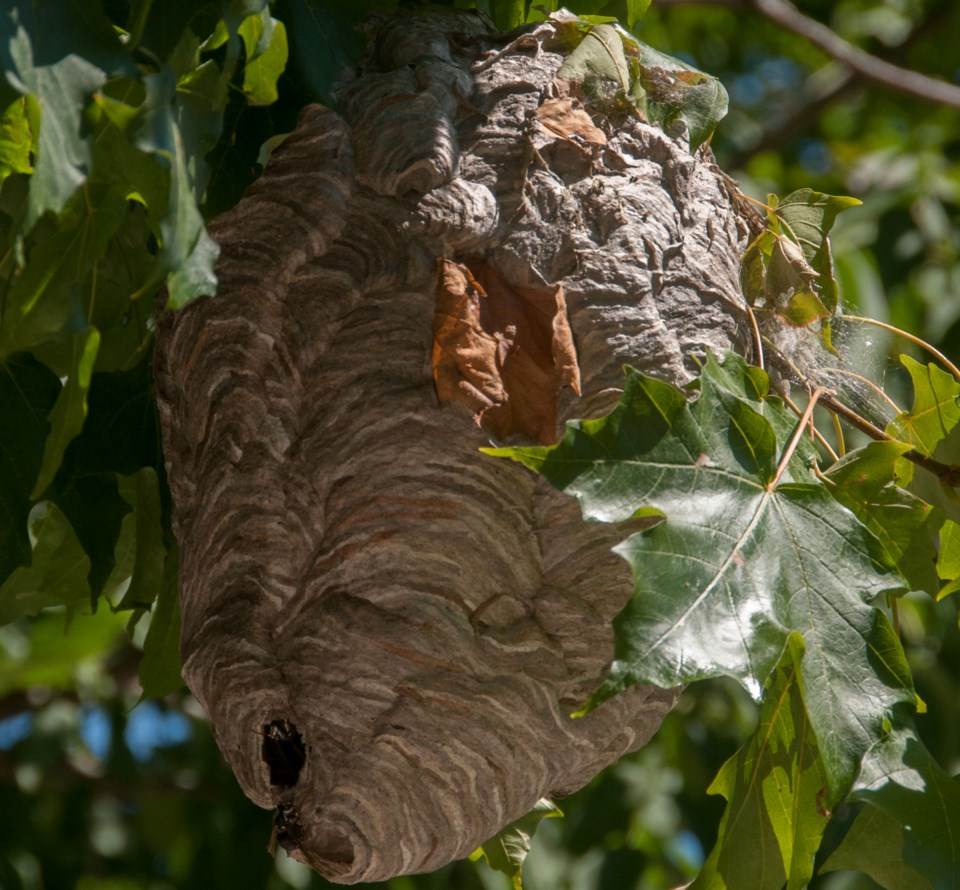They've been in the maple tree all summer, slowly but steadily building their fortress bigger and stronger. It's now late summer, and they are numerous, as generation after generation have been produced in the few weeks of summer.
Their home is no longer hidden amongst the foliage and has become huge and noticeable. I look up at the structure and flinch ... hornets!
My first reaction is to spray the nest with whatever I can find in the workshop. A quick inventory of my weapons of mass destruction comes up woefully inadequate. A partial can of wasp spray, that is about six years old, is the best I can locate. Harrumph, don't want to do half a job, might just get the survivors angry, and what might that lead to?
My second reaction is to get the shotgun and blow hundreds of holes through the basket-ball sized nest (living in a rural area allows me to come up with all sorts of options). But that would just result in a mangled maple tree, inquiring neighbours, and again it might just get the survivors angry.
My third reaction was to sit and watch the menace, study the enemy, find a weakness, hatch a plot, plan for victory. And so I sat, and watched, and did indeed come up with a plan.
Observations revealed these were bald-faced hornets, a medium-sized insect with black and white markings. And they were busy, busy, busy. One would exit the nest, pause for less than a second, and fly straight away towards the not-so-distant meadow.
No sooner had that one left, and two more would return, flying right into the entrance hole with their cargo of pollen or wood scrapings.
I moved closer. They ignored me. I wanted to move closer still, but was afraid they might no longer ignore me. The telephoto lens on the camera acted as a spyglass and like paparazzi at a star-drenched resort, I shot frame after frame of the same thing ... hornets coming and going, in and out of the entrance hole. After a while, this can and does get boring.
To add some excitement to the day, I decide to follow the departing hornets, to try to determine just where it was they were going to. Bald-faced hornets are somewhat easy to follow, as they are big enough to see and slow enough to follow, at least visually. Twenty metres at a time I'd follow, lose sight, wait for the next one to zoom by, follow it, lose it, wait for another. And finally we arrive at the meadow.
This hillside is covered predominately by goldenrod, Queen Anne's lace and a myriad of mints and asters. It is Hymenoptera heaven (Hymenoptera is the scientific way of collectively saying "bees, ants, wasps, and hornets").
As I (carefully) wade through the wildflowers, numerous bees and hornets fly by in all directions, this site being the Mighty-Mart of bee-dom. Not only are there honey bees, bumble bees, yellow jackets, paper wasps, and bald-faced hornets, but there are monarch and fritillary butterflies sipping nectar, and assassin bugs and ambush bugs hidden in the showy sprays of blossoms. On one goldenrod plant, a well camouflaged praying mantis is discovered.
Despite my presence, the hornets acted as if I didn't exist. They were so busy, almost frantic, with their nectar and pollen gathering that a slow-moving giant was of little concern to them. There was no nest to defend out here, so why get bent out of shape if a big two-legged beastie wants to wander aimlessly about.
A bit later, when I got back to the nest, the activity level at the entrance hole was much akin to downtown Toronto at lunch hour. And look there ... that one that just landed ... was that the one I had just seen in the meadow? Looks the same.
And so I got to know my enemy. They were pretty much a tight-knit group, not really bothering me or anyone else, just gathering groceries and collecting building supplies. They were very focused on doing their appointed tasks, and really didn't have time for the likes of me.
And so my plan came together. I would do ... nothing. This type of planning is quite easy to follow through on, and if I didn't get around to it, well, who would know?
However, I can't relax and ignore every wasp and hornet nest that shows up. I mean, what might the yellow jackets think if word got out that I'm a softie in the pest management department?
And so I give fair warning to things that sting: you mind your business and I'll mind mine. But cross that line and I'll bring the full force of chemical warfare into play ... if I remember to pick up a new can of Wasp-Be-Gone when I go shopping.



